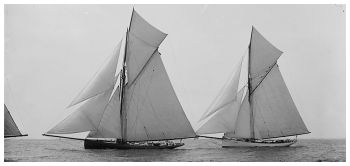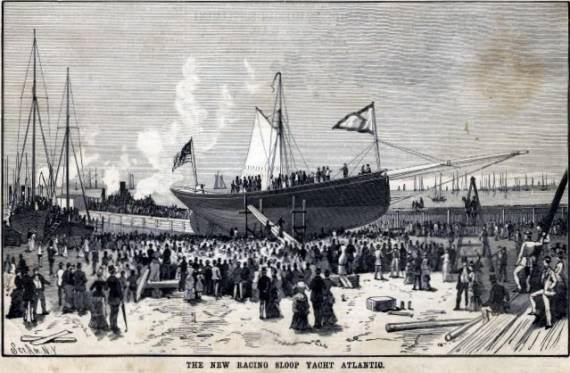Yves GARY Hits: 4226
Category: ATLANTIC
 The new sloop Atlantic, built as a candidate for cup-defense honors by a syndicate of Atlantic Yacht Club members, consisting of Messrs. Latham A. Fish, J. Rogers Maxwell, William Ziegler, Newbury D. Lawton, and others.
The new sloop Atlantic, built as a candidate for cup-defense honors by a syndicate of Atlantic Yacht Club members, consisting of Messrs. Latham A. Fish, J. Rogers Maxwell, William Ziegler, Newbury D. Lawton, and others.
It may be recorded here that Atlantic did not possess speed enough to make her a serious opponent to Mayflower.
She was built of wood by John F. Mumm of Brooklyn from designs by Philip Ellsworth of Bayonne, (brother of Capt. "Joe" Ellsworth) who had built the schooners Montauk, Grayling, and others.
She was the last of the rule-of-thumb sloops. Her dimensions were as follows: Length overall 95 feet 1 inch ; length on water-line 82 feet 1 inch ; extreme beam 23 feet 2 inches ; beam at water-line 22 feet 8 inches ; depth of hold 10 feet 6 inches ; draft 8 feet 10 inches, with centre-board down 20 feet 6 inches ; least freeboard 3 feet 3 inches ; displacement 108 tons ; ballast on keel 33 tons, inside 9 tons.
 The characteristic feature in the construction of the yacht is the extreme lightness of the materials employed. The frame is mad of oak and black larch, and the ceiling of Oregon pine. The clamps are of yellow pine. Her outside planking is also of Oregon pine, with the exception of the three upper strakes, and is 2 ½ inches in thickness. Many of these planks have been cut from mast stuff, and are fifty to sixty feet long. In the interior, metal knees made of cast steel, 4 by 1 ¾ inches, are used to resist the racking strain of the spars. Wooden hanging knees of each side support the strain on the deck. A shelf of yellow pine running round her side and under her beam ends will meet the torsion strains brought to bear upon her frame.
The characteristic feature in the construction of the yacht is the extreme lightness of the materials employed. The frame is mad of oak and black larch, and the ceiling of Oregon pine. The clamps are of yellow pine. Her outside planking is also of Oregon pine, with the exception of the three upper strakes, and is 2 ½ inches in thickness. Many of these planks have been cut from mast stuff, and are fifty to sixty feet long. In the interior, metal knees made of cast steel, 4 by 1 ¾ inches, are used to resist the racking strain of the spars. Wooden hanging knees of each side support the strain on the deck. A shelf of yellow pine running round her side and under her beam ends will meet the torsion strains brought to bear upon her frame.
The mainmast is 53 feet, with a gaff of 47 feet and a boom of 76 feet 6 inches. Her suit of racing sails numbers 15. They have been specially woven for the Atlantic, and vary in weight from the heaviest duck to the lightest cotton drilling. The spread of the mainsail is 4,000 square feet, and that of the large jib 1,150 feet. The club topsail adds 1,500 feet to her sail area, and the balloon jib topsail, intended for gentler breezes, 4,180 square feet. Her spinnaker boom is 72 feet long, and carries a sail of 4,400 square feet.
Atlantic was later converted to a schooner and is pictured here on September 22nd, 1894 in a Larchmont Yacht Club race.
|
When the season of last year was ended and the old hands had compared logs a number of gentlemen in the Atlantic Club of Brooklyn, a club that own more of Mr Ellsworth's models than any other decided that they would give the Ellsworth model for a sloop trial. The necessary money having been subscribed, the lean wedge of wood was placed in the hands of Architect John G. Prague, the owner of the fast sloop Crocodile designed by Ellsworth and the drawings were made by him. The contract to build the new boat was left to Mrs. John Mumm, the Bay Ridge shipbuilder.
From the day her keel was laid until Saturday May 1 when she glided gracefully down the ways with the wine gushing over her bows tram a bottle in the hands of the pretty 4-year-old daughter of Secretary F. C. Swan, not a blow was struck or a shaving curled but in the presence of admiring spectators. But not all the spectators were admirers; in fact neither of the other yachts has encountered such violent hostility as this new boat, the Atlantic. We doubt very much however, whether either of the other boats has excited as great confidence in its friends as she has, while with every day's trial this confidence grows stronger.
The Atlantic is 95 feet inch long over all. When launched and her ballast as first designed was in place, her waterline was 83 feet 8 inches. Since the extra lead has been added it is 84 feet. Her extreme breadth Is 23 feet 2 inches and her depth of hold 12 feet 3 inches. She now draws 9 feet 3 inches of water with her centreboard up. With her centreboard down she draws 20 feet 4 inches.
In model the Atlantic is radically different from the other big yachts, although this difference is not readily distinguishable since she is afloat. Her peculiarity is that her greatest breadth of beam is located much further aft than that of either of the others. Sixty-six percent of the Atlantic hull is devoted to the bow. That is, starting from the stem she grows broader and broader until at two-thirds of her length her greatest beam is reached and then she tapers down again toward the stern. Only 60 per cent of the hull of the Priscilla and 58 per cent of the Puritan is so used. The lines of the Atlantic's bow may be called straight. As Mr. Prague who made her drawing said yesterday: "If the Atlantic is right the rest are all wrong." Another peculiarity of this boat is that the greatest draught of water is under the frame that marks the greatest breadth of beam. The keel is a good rocker fore and aft. "That is the Ellsworth Idea," said Mr. Prague. |
 |
|
|
The keel rocks up aft as well as forward. She fines away in all directions under water from her greatest breadth of beam. When she comes about she turns around like a top on its peg. The talk about raking the stern post to help a boat in stays is all non-sense. It is of no advantage to rake a stern post. We raked the Atlantic's stern post so that it would fit the steering gear - that is, we wanted the wheel vertical, and having learned the angle which the one we intended to use made with the rudder post, we raked the stern post to match." "The Atlantic is like a darky," said another. "The hollow of her foot makes a hole in the ground. She tacks like a spinning dervish." In one other respect the Atlantic Is peculiar. The area of her midship section is more than 25 per cent larger than that of the largest of her competitors. The mathematical sharps have figured it at 102 square feet. It is probably larger than that. It has been argued from this that she had no chance of getting a place in the race with the other boats, but it must be remembered that she carries more canvas than any of the other boats, and that her model enables her to carry it now that she has her proper load of ballast. If a drawing of her midship section was laid down on the floor the draught of all the others could be laid down inside of it except the Priscilla's which would extend much beyond it at the water line, though far within at the bilge. Her displacement is set down at 126 tons. If she wins, high sterns and long bows will become popular at once. |
About the most difficult work a reporter has to do is to learn the amount of ballast a great yacht carries at the time she sails a race. There is so much shifting and changing that the owners seem to forget what they have on board. The facts in the case of the Atlantic, as near as ascertainable, are that 60 tons, and no more, of lead have been purchased for her. Of this 35 tons are on the keel and the rest is inside. This is 12 tons more than the Mayflower is said to carry. But with a lumpy sea and the kites all in, the weight of the Atlantic will be in her favor. In the trials so far the Atlantic has made a remarkable showing. On Thursday of last week she beat the Grayling by a mile in a race from Buoy 9 to Bay Ridge. The Grayling is queen of her class and is just off the ways. The Atlantic had been five weeks in the water. Her planking had soaked up, squeezing the caulking out of her seams, and fouling her bottom generally. When smoothed up and pot-leaded she will of course do much better. Those who want to bet against her will have no trouble in getting even money as against any other boat. Nevertheless, she is not perfect even in the eyes of her friends. Mr. Prague thinks her mast should be stayed six inches further aft. The main boom is so heavy that when she is running before the wind it cants the vessel over enough to affect her speed. When on the ways during the past week a foot was taken off of the lower corner of her centreboard, but no further alterations are now contemplated. |
|
